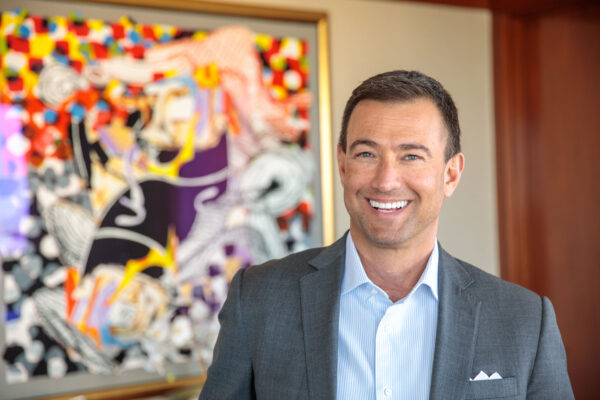
Roy Schoenberg, president and CEO of Amwell
MedCity News is a partner of HLTH, the organizer of ViVE.
Much of the buzz around telehealth since the emergence of Covid-19 — especially around the beginning of the pandemic — has been about the major spike in consumer use of virtual care. As social distancing became a household concept and elective procedures and other non-emergency care ceased to be offered in person, many people hopped online to see doctors and therapists.
The virtual behavioral health trend, for one, has remained strong. But as the virus has become a part of everyday life and in-person visits resumed, telehealth use has cooled. Given that, a recent report from Trilliant Health estimates only a modest market for telehealth in the future.
But in sit-down interview at the recent ViVE conference in Miami Beach, Amwell CEO Roy Schoenberg said all the headlines focused on consumers going online to see a doctor when they couldn’t get urgent care in person missed the bigger story. Even with the consumerization of healthcare, he thinks, it’s provider adoption and integration of teleheath that will drive greater use of the technology.
“It’s not the adoption of telehealth by consumers that’s the story,” he said. “It’s the adoption of telehealth by providers that’s the story.”
Schoenberg thinks that puts his company in a much better spot than those that provide telehealth direct to consumers.
“I think that is the marked distinction between us and the likes of Teladoc that have always believed in creating products that patients or consumers go to. Those have really, really suffered from the rise and fall of Covid,” he said. “People gravitated towards technology-based solutions during (the beginning of) Covid, but then when things opened up they said, ‘I don’t have to use this anymore. I can go back to whatever I was doing.’ And that is not our reality at all.”
Amwell went public during the pandemic in September 2020. Its stock has closed as high as $42.80 per share on the New York Stock Exchange. But since peaking on Jan. 27, 2021, it has fallen precipitously, and closed at $3.27 per share Friday.
Teladoc’s stock price spiked around the same time, closing at $294.54 on Feb. 8, 2021. And it’s also tumbled since, closing at $54.61 Friday.
Boston-based Amwell, which has billed itself as the “intel inside” company, works behind the scenes to deliver telehealth for the largest organizations in healthcare. That includes health systems like Cleveland Clinic and Intermountain, as well as health plans, employers and other partners. (Although it operates behind the scenes, Amwell openly shares who it’s doing business with.)
“The credibility of healthcare comes from the reputation of these organizations, not us,” he said. “We strongly believe that our future is in allowing these organizations to rewrite the way they manage patients.”
At a most basic level, digital-first care conceives of a consumer initially connecting with healthcare virtually, then as needed, getting in-person care. But Schoenberg conceives of another scenario, where a patient sees their doctor in the flesh first. Then, when they’re told they need to have a follow-up appointment — say, to discuss a medication they’re taking — they could be asked to do that virtually instead.
Video visits are just the tip of the iceberg, too, he noted. Increasingly, not only primary but specialty care is made available to people virtually in their homes. Technology is also used to monitor patients remotely. A blending of in-person care and virtual care along with remote monitoring allows a person’s level of care to be escalated based on their need and in real time, Schoenberg said.
Certainly, there’s consumer demand for being able to get care in a manner that’s safe and convenient. But Schoenberg remains steadfast in his belief that it is health organizations primarily, not patients taken initiative to access care virtually, that will bring about this transformation.
“The evolution of how we’re cared for is actually not going to come from consumer initiative,” he reiterated. “It’s going to come provider prescribed.”
Photo: sdecoret, Getty Images












